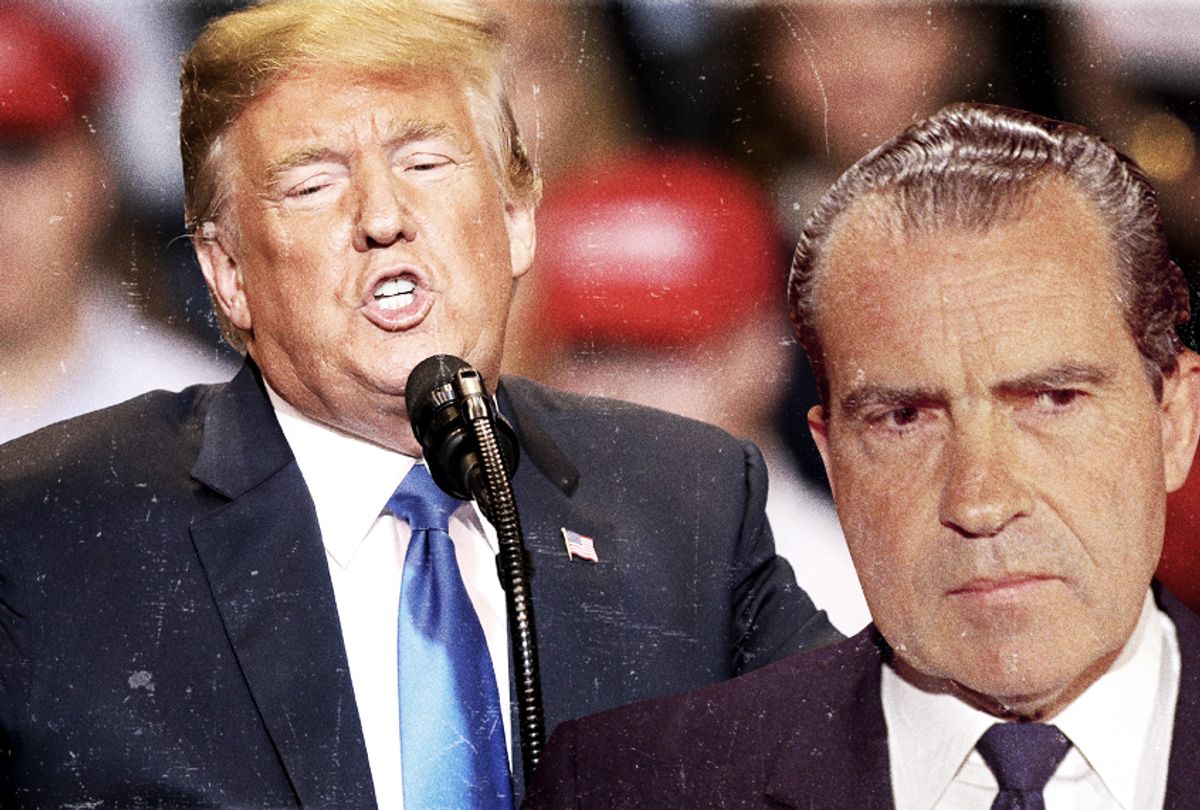With so many pundits arguing that President Donald Trump is alienating suburban voters, the president is stepping up his suburban outreach — and he is doing it in an overtly racist, fear-mongering way that recalls President Richard Nixon and segregationist George Wallace in the 1960s and 1970s.
During a speech on the White House's South Lawn on Thursday, July 16, Trump slammed former Vice President Joe Biden on housing policies and attacked a rule designed to combat segregation. Biden, Trump claimed, would "obliterate" the suburbs if elected president in November by causing property values to plummet and crime to skyrocket.
"Your home will go down in value and crime rates will rapidly rise," Trump claimed. "Joe Biden and his bosses from the radical left want to significantly multiply what they're doing now, and what will be the end result is you will totally destroy the beautiful suburbs. Suburbia will be no longer as we know it."
If that type of rhetoric sounds familiar, it's because Nixon and Wallace used similar arguments during the 1968 presidential election. Both of them ran on law-and-order platforms, going out of their way to convince white suburbanites that integration would destroy their communities. And when Trump vows to "protect the suburbs from being obliterated by Washington Democrats, by people on the far left that want to see the suburbs destroyed," it is right out of the racist Nixon/Wallace playbook.
"The suburban destruction will end with us," Trump declared during his July 16 speech.
Biden's campaign website calls for fair housing policies, noting, "Racial disparities in home ownership contribute to the racial wealth gap. It is far past time to put an end to systemic housing discrimination and other contributors to this disparity." To Trump, that is an attack on white suburbanites.
In terms of where Americans live, political strategists tend to divide voters into three main groups: (1) urbanites, (2) residents of rural areas and small towns, and (3) suburbanites. Trump has enjoyed his greatest success in rural areas and small towns — especially in red states, which are the heart of his white MAGA base. Urbanites, meanwhile, lean heavily Democratic: from Seattle to Los Angeles to New York City, Philadelphia, Boston and Washington, D.C., the United States' large urban centers are overwhelmingly Democratic. And Trump is wildly unpopular in those cities.
The suburbs are more complex. In the past, the suburbs of Los Angeles, NYC and Philadelphia were more GOP-friendly than the cities they were attached to. For example, Philly Proper has long been dominated by Democrats; Philly hasn't had a Republican mayor since the early 1950s, and Republicans are a minority on the Philadelphia City Council. But during the 1980s and 1990s, the Philly suburbs of Montgomery County, Bucks County and Delaware County elected a lot of Republicans — although they tended to be sane conservatives, not raving lunatics or far-right evangelical culture warriors. Republican Tom Ridge, now a Never Trumper, was popular in the Philly suburbs when he served as Pennsylvania governor during the 1990s. But when the far-right Pennsylvania Sen. Rick Santorum was voted out of office in 2006, he was rejected in Suburban Philly — which went overwhelmingly for centrist Democratic Sen. Bob Casey, Jr., now serving his third term.
The Greater Philadelphia Area is hardly unique in that regard. From Southern California to the Houston suburbs, the 2018 midterms found suburbanites voting heavily Democratic and rejecting Trumpism. And if suburbanites join urbanites in voting for Biden in November, it will be disastrous for Trump.
One thing that is making suburbia more racially integrated, ironically, is gentrification, which has been rightly condemned as a form of ethnic cleansing and social cleansing that forces African-Americans and other people of color (as well as working class whites) out of communities they have been a part of for generations. And many working class people of color, forced out of urban areas, have become neo-suburbanites. Trump, in essence, is trying to terrify white suburbanites by telling them they will have black neighbors. But many suburbanites already have black neighbors who found inner-city areas to be increasingly unaffordable thanks to gentrification.
Trump is obviously hoping to terrify suburbanites into voting for him. But if 2018 is any indication, doubling down on racism will not win over suburbanites — and it could alienate them instead.




Shares